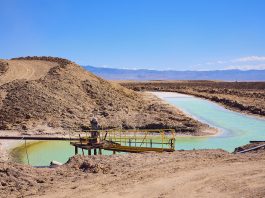SciAps’ LIBS technology offers quick and easy lithium detection with a handheld instrument.
Due to the rise of electric vehicles (EVs), the world is increasingly reliant on lithium. New sources are paramount. With that, the price of lithium is also rising. SciAps makes lithium detection with a handheld instrument possible. The high resolution of the spectrometers, combined with low detection limits for light elements, makes the laser-induced breakdown spectroscopy (LIBS) technique a powerful option to detect lithium and trace elements of first interest during mineral exploration, introducing advantages of portability and rapid analysis.
SciAps offers two LIBS analysers that provide the world’s only handheld technique for directly measuring lithium in the field. SciAps Z-901 Lithium is a dedicated lithium-only analyser, weighing only about 3.5lbs. The SciAps Z-901 Lithium is a purpose-built handheld LIBS analyser for measuring lithium in rocks and brines, factory calibrated for lithium in pegmatite, clays and micas, including relevant base elements in the 350-675 nm range. The SciAps Z-903 provides the same great lithium performance, but with a wider spectral range and the added capability of seeing any element on the periodic table. This allows for the analysis of other important elements that can be used to aid in lithium exploration, such as potassium (K) and rubidium (Rb), which, when ratioed as K/Rb, have been shown to help determine whether a host pegmatite is barren or fertile in terms of lithium enrichment.
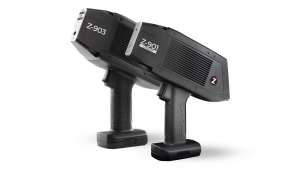
Key features in both LIBS analysers
The analysers include:
- An android operating system and app-based software to assure quality testing by every operator;
- Built-in Wi-Fi and Bluetooth, with GPS capability, which allow users to print, email, and connect to virtually any information management system for full-featured reporting;
- Automatically merge XRF and LIBS tests with SciAps Cloud Services, and easily manage operations from anywhere;
- Z-901 handheld LIBS analyser weighs about 3.9 lbs;
- Z-903 handheld LIBS analyser weighs about 4.9 lbs;
- An internal camera for precise targeting of analysis locations and a macro camera for photo documentation of samples, reading bar codes and QR codes;
- A patented ‘sample sensor’ that allows Class 1 operation (subject to LSO approval);
- High-resolution, rear-facing display for easy viewing;
- Rugged metal body for maximum durability;
- A tapered, narrow snout for difficult-to-access test locations;
- User-replaceable argon that provides hundreds of tests at a low cost; and
- Pair with Profile Builder software for PC or tablet to achieve full benchtop functionality.
The two main sources of lithium are hard rock lithium mineral deposits and lithium brines. SciAps LIBS analysers can be used to measure both solid and liquid samples. The most common rock type to host economic lithium concentrations is lithium-rich pegmatite, which can be found all over the world. Another rock type of interest recently in the US has been claystone in Nevada, and there is gaining interest in exploration and mining for mineralisation in this host rock. SciAps factory-calibrated analysis for lithium in pegmatite and clays utilises lithium regions and regions for relevant base elements in the 350-675 nm range with Z-901 Lithium analyser and the 190-950 nm range with Z-903 analyser.
Method and results from SciAps LIBS analysers
SciAps Z-901 Lithium and Z-903 use a high-energy (~6mJ per pulse), pulsed laser to ablate sample material and create a plasma. Light emitted from the plasma is then captured by the optics and detection system within the device to collect a spectrum. Characteristic emission lines from each element create peaks in the spectrum, which can be interpreted to produce both qualitative and quantitative results. Lithium is one of the most sensitive elements for the SciAps LIBS analysers, with a limit of detection less than 5 ppm in most solid sample types.
Whole rock pegmatite samples from northern Europe, southeastern US, Quebec, and Australia, representing a diverse and variable mineralogy from one locale to the next, were analysed with the factory-provided lithium pegmatite calibration. Lithium claystone samples from Nevada were also analysed using the SciAps Lithium Clay calibration. In order to achieve a more representative whole rock analysis, all samples were pulverised, homogenised, and pressed into pellets prior to analysis. Test times are less than five seconds.
Shown in Fig. 1, our handheld LIBS results in a diverse and variable set of pegmatite samples from multiple locations using the SciAps factory-provided Lithium Pegmatite calibration. Each point represents a three-test average. The average results are plotted up against the lab assays, showing correlation between the Z-901 Lithium or Z-903 and the lab.
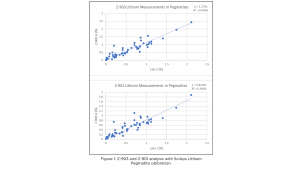
For improved accuracy, it is possible to fine tune calibrations to optimise for a particular site-specific matrix to improve the quality of the geochemical analysis. Fig. 2 shows results achieved after refining a calibration toward the GTA series of certified reference materials (CRMs) produced by Geostats, which are representative of pegmatite ore and spodumene concentrates from Western Australia.
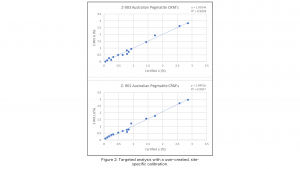
By targeting a more focused range of sample chemistry and grain size, and therefore limiting matrix effects, the LIBS accuracy can increase significantly. This is an example of how a site-specific calibration at a proposed mine site could enhance the performance of the LIBS over the already impressive factory-built calibrations.
For the claystone analysis, both the Z-901 and Z-903 were used to test a series of prepared Nevada claystone samples with lithium content varying from 0.002% to 0.335%. Results in Fig. 3 from both instruments show great correlation with the lab, with R2 values >0.99.
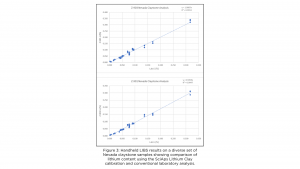
New method for rapid, in-field lithium brines analysis
With the first portable LIBS-powered lithium brines analyser, the Z-9 Liquidator test station combined with the Z-903 LIBS handheld analyser provides fast and easy analysis of brines in the field, plant, or lab. This groundbreaking technique uses only 1-2ML of sample per test, with no dilution necessary. The Z-9 Liquidator samples the liquid and atomises it into a fine mist, which is then analysed by the Z-903 LIBS analyser. Within seconds, the concentration of lithium and other key elements (like B, Na, Mg, K, and Ca) are displayed on a nearby tablet or PC. With SciAps Profile Builder software, users can also develop a custom calibration to further optimise performance or use the factory-built lithium brines calibration programmed in the Z-903 for accurate fast results. Calibrations are also available for pegmatite, Nevada clays, etc.
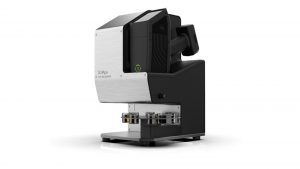
Because the Z-9 Liquidator is light, durable, and easily transported, it is versatile enough to analyse brines at the well or evaporation ponds. Users will no longer have to wait days, weeks, or sometimes months for lab results. Users can easily analyse solids and rocks, as well. Simply undock the Z-903 from the test station, and users can freely roam, testing outcrops, cores, pressed pellets, and more.
Handheld LIBS have advantages for lithium detection
Handheld LIBS can be used to quickly and accurately analyse lithium and other elements in the field. SciAps Z-901 Lithium is a lighter weight, dedicated lithium-only analyser, while Z-903 provides great lithium performance with a wider spectral range and the added capability of seeing any element on the periodic table, allowing geoscientists to deduce many important mineralogical associations. SciAps LIBS relies on empirically-built calibrations. LIBS relies on empirical-built calibrations, but factory-supplied pegmatite and clay calibrations can be effective and robust, with sample preparation being key to getting the most accuracy out of the instrumentation. For improved performance, site-specific calibrations also can be built. Labs may take weeks or months, but LIBS provides instant results that allow geologists the information they need to move quickly and make decisions, when every day spent in the field matters.
Please note, this article will also appear in the fourteenth edition of our quarterly publication.



